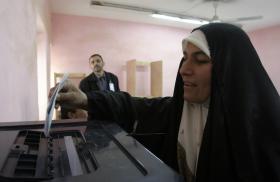
- Policy Analysis
- PolicyWatch 4042
Seizing the Moment of Opportunity in Syria: Guidelines for U.S. Action

Four experts discuss what the Trump administration needs to do to follow through on the landmark talks with President Sharaa, from sorting through the complex web of sanctions to managing allied expectations and safely handing over the counter-IS mission.
On May 21, The Washington Institute held a virtual Policy Forum with Matthew Levitt, Devorah Margolin, Souhire Medini, and David Schenker. Levitt is the Institute’s Fromer-Wexler Fellow, director of its Reinhard Program on Counterterrorism and Intelligence, and author of its recent report “Navigating the Syria Sanctions Conundrum.” Margolin, the Institute’s Blumstein-Rosenbloom Senior Fellow, recently hosted the “Hope for al-Hol?” episode of the “Syria Breakdown” video series. Medini is a visiting fellow at the Institute currently in residence from the French Ministry for Europe and Foreign Affairs. Schenker is the Institute’s Taube Senior Fellow, director of its Rubin Program on Arab Politics, and former assistant secretary of state for Near Eastern affairs during the first Trump administration. The following is a rapporteur’s summary of their remarks.
Matthew Levitt
Although the May 14 meeting with President Ahmed al-Sharaa was highly unusual given his past designation as a terrorist, it is not without precedent for U.S. officials to engage such figures. The real issue is not “once a jihadist, always a jihadist,” but whether Washington has any basis for trusting said figure going forward.
In this case, the picture is mixed. Sharaa was once selected by the late Islamic State (IS) leader Abu Bakr al-Baghdadi to lead al-Qaeda’s Syrian branch. Yet he later severed ties with jihadist groups, was denounced via fatwa by the radical cleric Abu Muhammad al-Maqdisi, and refrained from any involvement in international terrorist acts while leading the autonomous rebel administration in Idlib province. Today, his connections to U.S.-designated fighters who are part of Syria’s new military remain a serious concern, spurring the Trump administration to ask that they be removed from their posts. Yet Sharaa’s new government has also taken surprisingly constructive steps such as halting weapons transfers to Hezbollah, expelling Iranian forces, and taking action against IS based on U.S. intelligence.
To maintain leverage on Damascus, Washington has two main tools at its disposal: reactivating economic sanctions and maintaining a limited U.S. military presence on the ground, especially to secure the detention facilities holding IS members and their families. Although President Trump’s announcement following the talks with Sharaa suggested full sanctions removal, State and Treasury Department officials are looking for ways to provisionally suspend sanctions instead. This would enable full economic activity in Syria while preserving U.S. leverage on Sharaa to make sure he delivers on his commitments. In short, Washington seems to have chosen the “verify” route instead of “trust but verify.”
Notably, many of the sanctions in question—especially those enacted under the 2019 Caesar Syria Civilian Protection Act—cannot be lifted without congressional action. This includes the state-level sanctions that are most damaging to the new Syria. The Trump administration can temporarily pause enforcement of the Caesar Act, but repealing it will take time. Moreover, U.S. agencies were caught off guard by the president’s announcement, creating confusion about how exactly to implement his call for lifting sanctions. For all these reasons, the best approach at present is to suspend rather than terminate sanctions.
Devorah Margolin
While President Trump’s sanctions decision was unexpected, his emphasis on the counter-IS mission was not. Since 2014, fighting the Islamic State has been central to U.S. policy in Syria, particularly via the partnership with the Kurdish-led Syrian Democratic Forces. Although IS was militarily defeated in 2019, thousands of individuals affiliated with the group are still being held in SDF-run detention facilities. U.S. Central Command has long warned of the risk posed by these facilities. In 2023, military officials assessed that a U.S. withdrawal from Syria could lead to prison breaks, radicalization in the major camp at al-Hol, and a large-scale IS resurgence within one to two years.
Today, Washington is engaging with a different Syrian government, and many officials hope the new leadership in Damascus can help stabilize the country. At the same, however, the United States is seeking to reduce its regional presence and spending, including the Counter-ISIS Train and Equip Fund (CTEF) due to expire in 2026.
For now, Washington has asked President Sharaa to help prevent the resurgence of IS and assume responsibility for IS detention centers in the northeast. Many believe that such assistance—coupled with the new government’s proven willingness to act on U.S. intelligence regarding IS—could ease concerns about Sharaa’s past terrorist ties. Yet clarity is needed on how exactly Damascus intends to manage these tasks.
If Syria is to help with and ultimately take over the counter-IS mission, officials must first set expectations about detention facilities (e.g., security measures; humane treatment of prisoners), bridge any financial gaps, identify international support, and establish a clear timeline, among other prerequisites. Coordination with regional partners is also essential, as is balancing relations between Damascus, the SDF, Turkey, and European partners.
Souhire Medini
Europe has reacted positively to the U.S. policy shift on Syria. President Trump’s decision to engage with the new government strengthened the consensus inside the European Union and facilitated a move to lift, not just relieve, economic sanctions. The EU’s “trust but verify” approach is gradual and reversible, meaning sanctions can be reimposed based on developments on the ground.
This EU consensus is driven by two factors. First, Syria’s civil war had a profound impact on Europe, fueling major terrorist attacks and refugee crises. Engaging with Damascus is seen as a step toward preventing such violence and chaos from recurring in the future, echoing Secretary of State Marco Rubio’s stance. Second, Russia’s war against Ukraine has produced a strategic shift—the EU now seeks to reduce Syria’s dependence on Moscow instead of letting the Kremlin once again weaponize Syrian developments against Europe.
To be effective, however, European leadership still requires U.S. cooperation in four areas:
- Sanctions relief. U.S. secondary and tertiary sanctions remain a barrier. If this issue is not sorted out, European companies and banks will probably not invest in Syria.
- Chemical weapons. The United States and Europe should push for strong cooperation between Damascus and the Organisation for the Prohibition of Chemical Weapons to destroy the Assad regime’s remaining CW arsenal.
- The anti-IS mission. The situation in northern Syria remains a shared concern. As the fight against IS continues, any U.S. withdrawal must be coordinated with Washington’s coalition partners to avoid a repeat of what happened in Afghanistan.
- Transitional justice. U.S. and European officials agree that transitional justice must be part of any lasting resolution in Syria, since it is essential to ensuring accountability, avoiding violence, fostering reconciliation, and building a stable Syria.
David Schenker
President Trump’s decision to end five decades of U.S. sanctions on Syria reportedly came at the urging of Saudi Crown Prince Muhammad bin Salman and Turkish President Recep Tayyip Erdogan. Although the move surprised many observers, it aligns with his pattern of abrupt foreign policy decisions, such as his 2018 order to withdraw U.S. troops from Syria after a call with Erdogan.
Previously, U.S. sanctions relief on Syria was tied to eight conditions that Deputy Assistant Secretary of State Natasha Franceschi outlined to Foreign Minister Assad al-Shaibani at the March donor conference in Brussels. These included expelling Palestinian terrorists, removing foreign fighters, taking control of IS camps, aiding the fight against IS, and investigating the disappearance of American journalist Austin Tice. With sanctions now suspended, much of Washington’s leverage on such issues is diminished.
Moreover, the fact that this decision stemmed from conversations with Erdogan and Crown Prince Muhammad underscores the growing influence these leaders have over Trump’s foreign policy—a significant diplomatic victory for Turkey and Saudi Arabia. Ankara has been a key player in Syrian affairs for nearly a decade, and a Turkish-backed militia collective, the Syrian National Army (SNA), provided pivotal support to the rebel offensive that toppled Assad. Erdogan aims to retain this local sway under Sharaa’s new government, while the Saudis hope to exert themselves by leveraging humanitarian aid and contesting Turkish influence.
Other regional players differ in their expectations for the new Syria. Jordan and Lebanon hope the shift in U.S. policy brings stability to their neighbor and enables the return of millions of Syrian refugees. Yet Iran, a longstanding ally of the Assad regime, views Sharaa’s pivot toward the West unfavorably, while Russia is no doubt upset that Damascus terminated its contract on the Tartus naval base. Israel is displeased with Washington’s policy shift as well, preferring a weak and divided Syria. Trump’s sanctions announcement is the third major Middle East policy move he has made without informing Jerusalem in advance, raising concerns about how his administration’s ongoing nuclear negotiations with Iran will turn out.
This summary was prepared by Sarah Boches. The Policy Forum series is made possible through the generosity of the Florence and Robert Kaufman Family.






